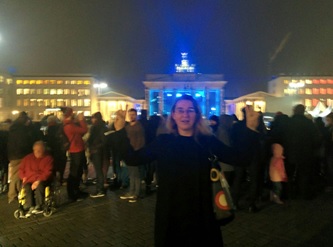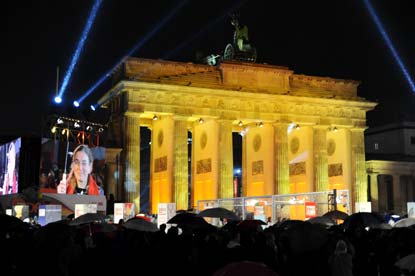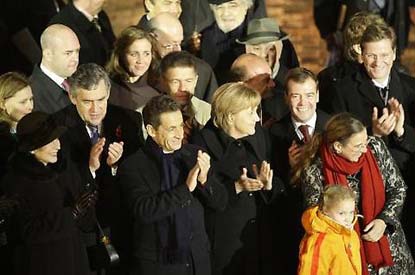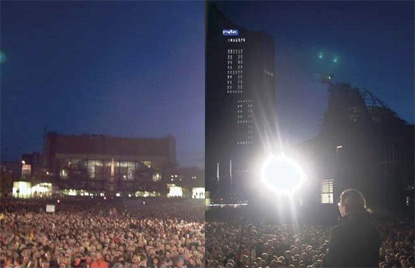

Documentaries/public discussions (participation/collaboration) (some):
"Angst vor Strafe (Fear of punishment)“, talk with R. Eppelmann and K. Hattenhauer, Planet Wissen, Südwestdeutscher Rundfunk SWR, 8.10.2014
"Wege ins Licht (Paths to Light)“, talk with K. Hattenhauer, SWR, 17.6.2012
"The Rebels - Regime Change in East Germany“, documentary on the peaceful revolution, Deutsche Welle (DW), broadcasted in English, Arabian, German and Spanish, 2014, accessible via [accessible via]
„Fall of the Berlin Wall – 25 Years on“, Agenda, talk with K.Hattenhauer, J.Kornblum, R. Lentz, Deutsche Welle, [accessible via]
"Von sanften und friedlichen Revolutionen“, Gespräch mit Jan Budaj, B. Grexa, K. Hattenhauer, M. Meckel, A. Popovic, Slowakische Botschaft zus. mit der Bundesstiftung Aufarbeitung, 24.11.2014
Public Discussion with the German Secretary of Justice, Heiko Maas, former foreign secretary K. Kinkel, Prof. H. Hütter and journalist G. Mascolo, 03.11.2014
"Was Deutschland zusammenhält? (What keeps Germany together?)“, Talk at Max, Munich 03.10.2009
Film und Gesprächsreihe zum Fall der Mauer (Movie and Talks about the fall of the Berlin Wall), ARD Morgenmagazin, Berlin 09.11.2009
DDR im niederländischen Fernsehen, Berlin 2009
“Moskau, Mythen, Mauerfall (Moscow, Myths, and the Fall of the wall)“, Film von I. Lozo, Phoenix/ZDF, Berlin 2009
The Wall – A World divided, Houston PBS, E. Stange, 2009
“Mauerfall (Fall of the Wall)”, Deutsche Welle, Berlin 2009
“The secret Life of the Berlin Wall”, BBC, K. Sim, 2009
“Leipziger Herbst 1989 (Autumn in Leipzig 1989)“, ZDF, Berlin 2009
"Aufstand und Anpassung (Rebellion and Adjustment)“, MDR Figaro, 2009
"Ils ont fait tomber le mur de Berlin", TV1, 2009
"Half a life ago..., an interview with Dough Sanders", The Globe and Mail, Toronto, Nov.2009 [accessible via]
Central celebration of the Federal Republic of Germany “20th anniversary of the Fall of the Wall”, address at the Brandenburg Gate as representative of the former opposition
Central celebration of the City of Leipzig, 20th anniversary of Mondaydemonstrations, 9-10-2009, addressing 200000 people at Leipzig
Celebration of Freedom - 20 Years Fall of the Wall, 9-11-2009



"Our banner read "For an Open Country with Free People". This was our dream back then and my friends and me were willing to do everything for it, willing to fight for it. This is what I went to prison for in the end. What was special to us when I was released was that the country had changed. My very own freedom as well as democracy had been eked out on the streets of this country. Tha´s the magnificent accomplishment.
Here in Berlin I want to remind you that this freedom was eked out in the whole country, Berlin included. But it was in the city of Leipzig, where on the 9th of October 70.000 people lost their fear - or more precisely - overcame their fear and brought a dictatorship to its knees. That's what made this celebration possible.
And I want to repeat it yet another time: our dream was an open country with free people. Therefore I want to give this message to the young people, the ones among you that are 20 today, just like I was back then: dream and do everything for your dreams. What this story shows is that dreams can become reality - that we can make them reality.
Take this freedom for yourselves."
Festival of Light in Leipzig - 20 years Peaceful Revolution, 9-10-2009

"It is something very special for me to stand here in front of you. 20 years ago I could not make it. I was in prison. I want to use this opportunity to thank each and everyone of the 70.000 protestors, who on the 9th of October transformed this country and fought for my freedom and the freedom of so many others held in prison.
Thank you also to our friends in all of eastern Europe. Maybe some of you get the chance to see or hear me here today. The Solidarnosc in Poland and the Charta 77 were pioneers and supporters for us in the time of the few.
We were few, we had fear and we were brave.
We risked something and we won. We in Leipzig are a role model for our country. We were not given democracy, we fought for it. That was the miracle of Leipzig.
So let us celebrate our freedom today."

BEYOND THE
Half a life ago, Katrin blew the Wall down
DOUG SAUNDERS
November 7, 2009
She knew, from the air of distress among her Stasi guards, that something was going on. But it was damningly hard to make the distinction: Was this the thundering surge of huge numbers of people rising against the state, or of tanks and columns of soldiers restoring order?
It was Monday, Oct. 9, 1989. In a month, it would be her 21st birthday. It seemed unlikely she would live that long. Cancer had nearly killed her five years before, and now the Stasi, the East German secret police, had told her that they wanted her dead, soon.
She had been locked in isolation for five weeks, after being picked out of a crowd of hundreds and arrested for insurrection as she carried a large, cloth banner: "For an open country with free people."
The last time any East Germans had made such an explicit call for openness, in 1953, hundreds had been massacred by Soviet tanks, and nobody had dared protest openly for democracy after that.
Her Stasi interrogator had said to her, during one of their lengthy sessions: "When things start outside, when we are given the order to start shooting, you can be sure that you will be the first in this jail to be put up against the wall."
Unbeknownst to
During her confinement, the tiny, silent peace protests they had been holding on Mondays in the square of Leipzig's St. Nicholas Church had metamorphosed into a full-scale revolt with thousands of people, then into a mass insurrection with tens of thousands, then into a national revolution, bringing a million people onto the streets, that would precipitate the end of the Berlin Wall exactly a month later, on the night of Nov. 9.
When
Nor was the Wall's fall the event that triggered the end of East German communism. That pivotal event, the day that ripped past from future, had taken place exactly a month earlier, in
Its eruption was what Katrin Hattenhauer had felt shaking her prison-cell bed. It was the eruption she and her friends had launched.
The rumbling she felt on Oct. 9 had been the force of 70,000 people marching past and occupying the city's downtown district. Tanks, dogs and train-loads of shells had been shipped into the city that morning, and stood waiting at the train station, along with thousands of troops.
The soldiers were under direct orders from Erich Honecker, the leader of the German Democratic Republic, to prevent the occurrence of mass protests "from the start," and, if provoked in any way, to respond "offensively." Only four months earlier, tanks had cleared
But the soldiers did not fire. They didn't even block anyone's path. Mr. Honecker was shocked, and only a few days later the magnitude of the Oct. 9 protest (and the even-larger ones encouraged by its lack of violence) would force him to resign.
Their decision not to shoot - apparently made without much discussion - owed much to the collapse of East German confidence. Russian premier Mikhail Gorbachev had made it clear a year before that he wouldn't use Soviet troops to enforce communism in satellite states.
But even more important was the tradition of calm, tranquil protest that began in Leipzig as "prayers for peace" with a few dozen people holding candles, expanded into the Monday demonstrations and then inspired the quiet queues of people who chanted open the Wall on Nov. 9.
On that Monday, the soldiers searched for provocations that might justify a violent response, but found none. "We were told we would be facing counterrevolutionaries," one soldier explained later, "and we realized it was just people like us."
It was the ultra-communist showroom of the Bloc
To understand what had made people here arrive so late to the world of democracy, and then to demand it in such an insistent, calm way, you have to understand the nature of the German Democratic Republic, as it was then known.
Instead, it had been rigidly authoritarian, with a third of the population reporting their friends and neighbours to the Stasi, and very tightly controlled. It played a special role in the Eastern Bloc: It was a garrison state for 500,000 Soviet troops; it was also the model socialist society, a showcase of co-operative success on the edge of the fractious West.
When the Berlin Wall was built in 1961 by Mr. Honecker, then a mid-ranking official, it had been not just a symbol but a very tangible extension of the physical, ideological and psychological barriers that girded this country.
But
It took a second East German generation, those who had been born more than a decade after
This generation had grown up with neither the ideological zeal and optimism of their parents (as the socialist economy had begun to decline precipitously into debt and dependency in the 1970s), nor the mortal terror that gripped those who had experienced the Red Army invasion of 1945 and the slaughter of 1953.
At the same time, they had grown up with access to foreign TV and radio, and far easier travel: By the 1980s, six out of 10 East German families owned a car (albeit a cheap plastic Trabant), and could holiday anywhere in the Bloc.
"I didn't understand historically what was going on around me, but what was clear to me as a teenager was that the state was lying constantly," Katrin Hattenhauer, who was born in 1968, told me. Her father had died shortly before her birth, and she had watched her mother, a nurse, forced to have the "privilege" of working 12-hour shifts to support her four children.
"When there were elections, we'd hear on state television that Honecker had won with 99.9 per cent of the vote. ... The place I lived seemed both absurd and dishonest. So my protest activities came from a very personal place."
Starting in 1982, students began holding tree-plantings (some of which were violently crushed by the regime) and ecological protests. Ms. Hattenhauer had battled cancer at the age of 15, and the state nearly abandoned her because it believed she would die; neither further treatment nor education was considered worth the money.
When she survived, it gave her a defiant attitude: This led her to enroll in the
One of them was Rainer Müller, two years her senior, a serious young man who, like her, had been an inveterate protester from his early teens. Unlike her, he had travelled abroad, in 1988 going to
"When I began to talk to historians in Czechoslovakia, I came home feeling quite certain that the regime would collapse some day - that I would have children and that they would not be learning from the same lying textbooks I did," he told me at a café across from the church in Leipzig, where he still lives.
"By the fall of 1989, it seemed clear that the regime was mainly concerned with saving face - they wanted to figure out how best to manage the inevitable revolution for temporary advantage."
The "peace prayer" protests (only a small fraction of the participants had religious beliefs) and environmental statements had not been intended to challenge the existence of the state. Nobody dared imagine that. But the mood in
And one of the only vehicles for change was the small circle of protesters in
"No one was dreaming that the Wall would fall," Ms. Hattenhauer said. "That was unimaginable - 1989 was a year of escalation, where we had the feeling the state was getting more dangerous. People were being arrested faster and disappearing faster. Nobody had sensed that the system was kaput economically."
By July, after news of
But the protesters became organized. There was a circle of half-a-dozen young students who became very adept at sidestepping the Stasi. Mr. Müller devised ways to stay in touch with other protest groups forming in different cities. And he developed a way to get videotapes of protests, and subtle messages of coming ones, smuggled out to the West, where they would be broadcast on TV stations that could be received in towns close to the border such as
Ms. Hattenhauer became skilled at creating and sending messages: She hid a set of photocopying machines in her dorm room, which was part of a convent and therefore immune from sudden searches.
Starting on Sept. 11, the protests suddenly started attracting very large numbers of people, in the hundreds. And the Stasi responded with savage beatings and multiple arrests.
"In the fall, the feeling was very nervous and tense," she recalled. "Most of us thought that the state was like an injured animal that was about to lash out irrationally. The only way we were going to prevent it from killing us was with numbers of people."
She was arrested at that early-September protest, along with several other protesters and leaders, as a warning to other possible protesters: This could happen to you.
But it backfired. As a direct consequence, the crowds grew exponentially, from thousands to tens of thousands to hundreds of thousands. Mr. Müller and his colleague Uwe Schwabe, an army veteran, penned a set of demands that were presented to the government. They expected a gradual loosening and reform. Instead, after the growing mobs of early November, the government simply stepped down.
She blows out candles -
and the lights of the state
Three weeks after her release from prison, on Nov. 9, Katrin Hattenhauer took the train to
But she wanted to celebrate her 21st birthday, on Nov. 10, so she defied the Stasi and went to meet her friends at a bar on Bornholmer Strasse, near a fortified checkpoint. Later in the evening, guests started leaving because they had heard a rumour that the Wall had opened.
Nobody believed it until the bar owner himself shut down the place, ushered everyone out and made his way down the street to the crossing.
What had happened at the Wall that night, like what had happened in
An official had announced, earlier that day, that more-liberal travel policies would soon be in effect. Without clear instructions, he mistakenly announced that they were in effect immediately. Within an hour, East Germans were rushing to the border crossings to find out if they could get visas to the West.
The bureaucratic confusion and the sheer number of people pressing at the gates, especially those at
Shortly after that, the heroes of 1989 simply melted into the crowd. Unlike in
Mr. Müller stayed east and had the family he had put off during the underground years, staying an environmental activist. Ms. Hattenhauer moved west and became an artist. Most of their colleagues followed similar paths: Now in their early 40s, they reminisce about the moment, half a lifetime ago, that they changed history.
"It was completely absurd: We didn't really believe it until we saw it," Ms. Hattenhauer said while making me coffee in her flat in one of the quiet bedroom communities that make up much of the former West Berlin, now that the city's core has shifted sharply east.
"It was almost cute to see how the East Germans just went to see if it could possibly be true, and just by being there in such numbers they made it come true.
"For me, it was a sign of what could have happened had we gone to the Wall years earlier, instead of doing a typical German revolution where we all went to work during the day and then we went to the St. Nicholas Church afterwards and protested."
She laughed at this, and reflected for a moment. "Maybe something would have happened much earlier if we'd done that, but we went about it in a very organized, very peaceful, German way, so it took a lot longer."
Doug Saunders is a member of The Globe and Mail's European bureau.